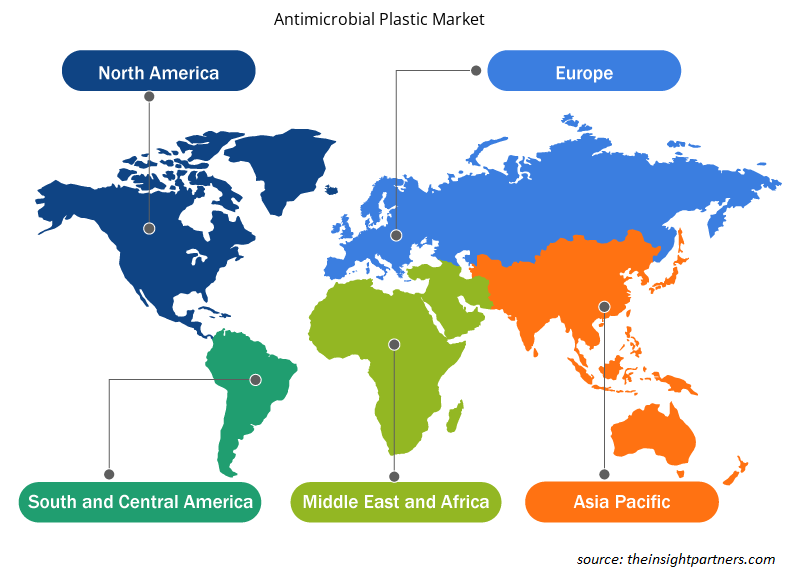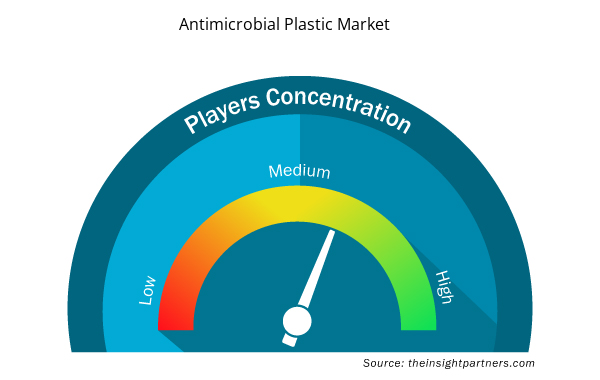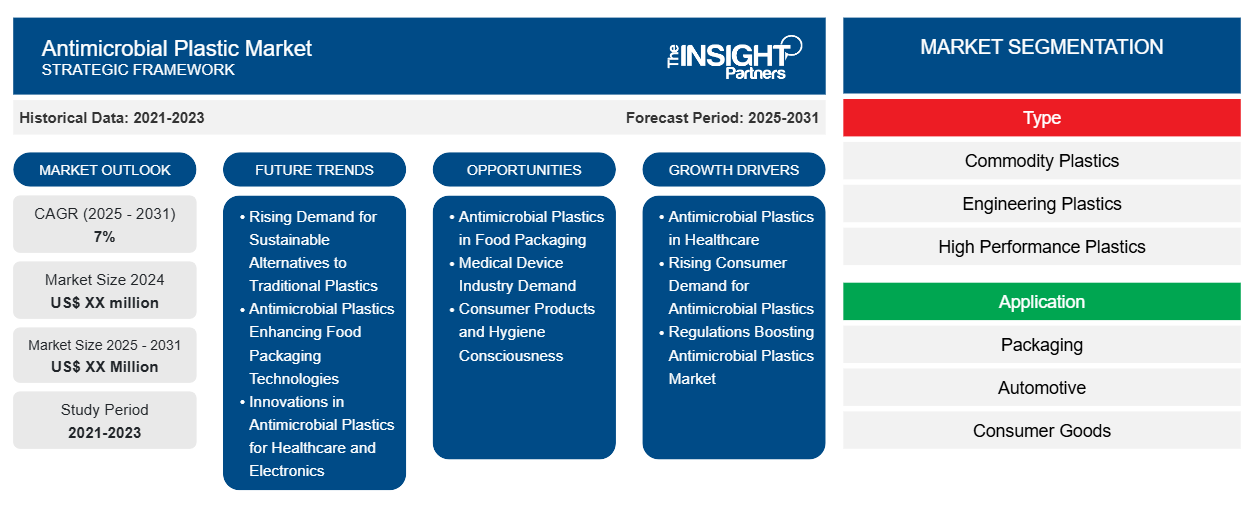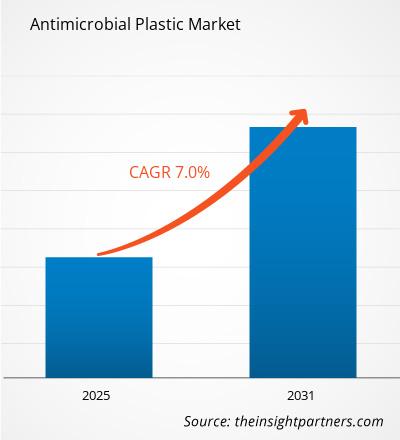抗菌プラスチック市場は、2024年から2031年にかけて7%のCAGRで成長し、市場規模は2024年のXX百万米ドルから2031年にはXX百万米ドルに拡大すると予想されています。
レポートは、タイプ(汎用プラスチック、エンジニアリングプラスチック、高性能プラスチック、その他)別にセグメント化されています。グローバル分析は、地域レベルと主要国でさらに細分化されています。レポートではさらに、アプリケーション(包装、自動車、消費財、医療とヘルスケア、建築と建設、その他)に基づいた分析を示しています。グローバル分析は、地域レベルと主要国でさらに細分化されています。すべての主要な市場セグメントの市場規模と予測は、グローバル、地域、および国レベルでカバーされています。レポートでは、上記の分析とセグメントの値をUSDで提供しています。レポートでは、主要な市場プレーヤーの市場状況に関する重要な統計を提供し、市場の傾向と機会を示しています。
報告書の目的
The Insight Partners による抗菌プラスチック市場レポートは、現在の状況と将来の成長、主な推進要因、課題、機会を説明することを目的としています。これにより、次のようなさまざまなビジネス関係者に洞察が提供されます。
- テクノロジープロバイダー/メーカー: 進化する市場の動向を理解し、潜在的な成長機会を把握することで、情報に基づいた戦略的意思決定が可能になります。
- 投資家: 市場の成長率、市場の財務予測、バリュー チェーン全体に存在する機会に関する包括的な傾向分析を実施します。
- 規制機関: 市場の濫用を最小限に抑え、投資家の信用と信頼を維持し、市場の完全性と安定性を維持することを目的として、市場における政策と警察活動を規制します。
抗菌プラスチック市場のセグメンテーション
タイプ
- 汎用プラスチック
- エンジニアリングプラスチック
- 高性能プラスチック
- その他
応用
- パッケージ
- 自動車
- 消費財
- 医療とヘルスケア
- 建築・建設
- その他
要件に合わせてレポートをカスタマイズする
このレポートの一部、国レベルの分析、Excelデータパックなど、あらゆるレポートを無料でカスタマイズできます。また、スタートアップや大学向けのお得なオファーや割引もご利用いただけます。
- このレポートの主要な市場動向を入手してください。この無料サンプルには、市場動向から見積もりや予測に至るまでのデータ分析が含まれます。
抗菌プラスチック市場の成長要因
- ヘルスケアにおける抗菌プラスチック: 抗菌プラスチックは、細菌や真菌の増殖を抑制する特性があるため、ヘルスケア分野でニッチな存在となっています。より安全で、より大きく、より持ちやすい感染制御医療機器の需要と供給の急増により、外科用器具、カテーテル、IV チューブなどのヘルスケア関連のプラスチック製品に抗菌添加剤が使用されるようになりました。これは、患者のヘルスケアを向上させる滅菌製品の必要性によるものです。
- 抗菌プラスチックに対する消費者の需要の高まり: 清潔さに対する意識が高まり、ウイルスから身を守る必要性が高まっているため、抗菌プラスチックが多くの消費者製品に使用されています。自動車業界では、スマートフォン、キッチン用品、パーソナルケア用品、自動車部品、その他さまざまな製品に抗菌プラスチックを使用し、製品を改善して、結果として市場を回復し拡大しています。
- 抗菌プラスチック市場を後押しする規制: 政府や管理機関は、病気の蔓延を抑えるために、公共交通機関、病院、教育機関などで抗菌プラスチックを使用するよう義務付けています。また、公共の表面の清潔さを奨励することを目的とした規制により、ドアノブ、手すり、ベンチなど、人が頻繁に接触する場所で主に使用される抗菌プラスチックの市場が拡大しています。
抗菌プラスチック市場の将来動向
- 従来のプラスチックに代わる持続可能な代替品の需要の高まり: 持続可能性を重視し、従来のプラスチックに代わる原材料の探求が絶えず行われています。これは、プラスチックの過剰使用は好ましくないが、包装、ヘルスケア、消費財などにおけるこれらのプラスチックの利点、つまり抗菌特性を維持したいと考えている消費者や業界に、プラスチックを提供したいという願望から生まれています。
- 抗菌プラスチックによる食品包装技術の強化: 抗菌プラスチックは、食品包装技術の重要な要素として登場します。パッシブ パッケージとアクティブ パッケージを最適に統合し、微生物の増殖を起こさずに製品の鮮度を長期間維持するインテリジェント パッケージの用途が拡大すると予想されます。これらのケースには、内容物の完全性と品質を追跡できるガジェットが組み込まれているため、抗菌プラスチックは将来の食品の安全性と保存技術の重要な要素となります。
- ヘルスケアおよび電子機器向け抗菌プラスチックの革新: 消耗品内に抗菌作用を持つポリマーを効果的に開発する動きは、医療機器や家庭用電子機器の分野でより顕著に表れるでしょう。耐久性、耐熱性、耐薬品性、抗菌性を向上させるプラスチック配合の新しい革新が、市場拡大の原動力となるでしょう。将来間違いなく必要となるのは、スマートフォン、コンピューターのキーパッド、その他人との接触を必要とする電子機器などの製品の表面に使用される抗菌プラスチックの製造です。
抗菌プラスチック市場の機会
- 食品包装における抗菌プラスチック: 食品の安全性と衛生のトレンドにより、食品包装における抗菌プラスチックの使用が促進されています。微生物の増殖を抑制する包装は、特に生鮮食品などの消費財の品質と安全性の維持に役立ちます。これは、食品包装が食品の品質を維持し、輸送中の汚染リスクを最小限に抑えるために重要なオンライン食品配達市場の場合には特に当てはまります。
- 医療機器業界の需要: 医療機器業界では、特に血液バッグ、注射器、診断機器など、アクセスしやすく感染リスクが高い部品で抗菌プラスチックの使用が増加するでしょう。より多くの病院、診療所、在宅医療施設が感染制御対策をうまく実施するにつれて、医療グレードの抗菌プラスチックの需要が増加するでしょう。
- 消費者製品と衛生意識: 消費者の衛生意識の高まりにより、携帯電話やコンピューター、その周辺機器など、さまざまな日常的な製品に抗菌プラスチックが利用されるようになります。特にパンデミックから抜け出そうとしている今、抗菌表面を備えたデバイスが利用できるようになったことで、メーカーは健康と衛生に気を配る消費者をターゲットにすることで、競争の激しい市場で目立つチャンスがあります。
抗菌プラスチック市場の地域別分析
予測期間を通じて抗菌プラスチック市場に影響を与える地域的な傾向と要因は、Insight Partners のアナリストによって徹底的に説明されています。このセクションでは、北米、ヨーロッパ、アジア太平洋、中東、アフリカ、南米、中米にわたる抗菌プラスチック市場のセグメントと地理についても説明します。

- 抗菌プラスチック市場の地域別データを入手
抗菌プラスチック市場レポートの範囲
| レポート属性 | 詳細 |
|---|---|
| 2024年の市場規模 | XX百万米ドル |
| 2031年までの市場規模 | XX百万米ドル |
| 世界のCAGR(2025年~2031年) | 7% |
| 履歴データ | 2021-2023 |
| 予測期間 | 2025-2031 |
| 対象セグメント | タイプ別
|
| 対象地域と国 | 北米
|
| 市場リーダーと主要企業プロフィール |
|
抗菌プラスチック市場のプレーヤーの密度:ビジネスダイナミクスへの影響を理解する
抗菌プラスチック市場は、消費者の嗜好の変化、技術の進歩、製品の利点に対する認識の高まりなどの要因により、エンドユーザーの需要が高まり、急速に成長しています。需要が高まるにつれて、企業は提供を拡大し、消費者のニーズを満たすために革新し、新たなトレンドを活用し、市場の成長をさらに促進しています。
市場プレーヤー密度とは、特定の市場または業界内で活動している企業または会社の分布を指します。これは、特定の市場スペースに、その規模または総市場価値と比較して、どれだけの競合相手 (市場プレーヤー) が存在するかを示します。
抗菌プラスチック市場で事業を展開している主要企業は次のとおりです。
- BASF SE株式会社
- バイエルマテリアルサイエンスAG
- バイオコートリミテッド
- クラリアントAG
- デュポン・ド・ネムール社
免責事項:上記の企業は、特定の順序でランク付けされていません。

- 抗菌プラスチック市場のトップキープレーヤーの概要を入手
主なセールスポイント
- 包括的なカバレッジ: レポートでは、抗菌プラスチック市場の製品、サービス、タイプ、エンドユーザーの分析を包括的にカバーし、全体的な展望を提供します。
- 専門家による分析: レポートは、業界の専門家とアナリストの深い理解に基づいてまとめられています。
- 最新情報: このレポートは、最新の情報とデータの傾向を網羅しているため、ビジネスの関連性を保証します。
- カスタマイズ オプション: このレポートは、特定のクライアント要件に対応し、ビジネス戦略に適切に適合するようにカスタマイズできます。
したがって、抗菌プラスチック市場に関する調査レポートは、業界のシナリオと成長の見通しを解読し理解する道の先導役となる可能性があります。いくつかの正当な懸念があるかもしれませんが、このレポートの全体的な利点は欠点を上回る傾向があります。
- 過去2年間の分析、基準年、CAGRによる予測(7年間)
- PEST分析とSWOT分析
- 市場規模価値/数量 - 世界、地域、国
- 業界と競争環境
- Excel データセット



Report Coverage
Revenue forecast, Company Analysis, Industry landscape, Growth factors, and Trends

Segment Covered
This text is related
to segments covered.

Regional Scope
North America, Europe, Asia Pacific, Middle East & Africa, South & Central America

Country Scope
This text is related
to country scope.
よくある質問
Use in sustainable and biodegradable plastic products is expected to be the key market trends
Based on type, the engineered plastics segment is expected to witness the fastest growth during the forecast period
Based on geography, Asia Pacific held the largest share of the antimicrobial plastic market due to the growing healthcare industry across the region, coupled with continuous growth and development
Expansion in healthcare applications is driving the market growth
BASF SE
; Microban International
; DSM
; PolyOne Corporation
; SABIC
; Clariant International Ltd.
; Momentive Performance Materials
; Hexpol TPE
; U.S. Antimony Corporation
; Eastman Chemical Company
; Ticona
; LyondellBasell
; SABIC Innovative Plastics
; Innovia Films
; Allnex
The Antimicrobial Plastic Market is estimated to witness a CAGR of 7% from 2023 to 2031
Trends and growth analysis reports related to Chemicals and Materials : READ MORE..
The List of Companies
- BASF SE Corporation
- Bayer Material Science AG
- Biocote Limited
- Clariant AG
- Dupont De Nemours Inc.
- King Plastic Corporation
- Lonza Group AG
- Microban International Ltd.
- PARX Plastics N.V.
- Polyone Corporation
- Sanitized AG
- Milliken Chemical
- RTP Company
- Compounding Solutions LLC
- Ray Products Company Inc.
- Covestro AG
- Steritouch
- Doeflex Vitapol
- Ticona Engineering Polymers
- Dow
The Insight Partners performs research in 4 major stages: Data Collection & Secondary Research, Primary Research, Data Analysis and Data Triangulation & Final Review.
- Data Collection and Secondary Research:
As a market research and consulting firm operating from a decade, we have published and advised several client across the globe. First step for any study will start with an assessment of currently available data and insights from existing reports. Further, historical and current market information is collected from Investor Presentations, Annual Reports, SEC Filings, etc., and other information related to company’s performance and market positioning are gathered from Paid Databases (Factiva, Hoovers, and Reuters) and various other publications available in public domain.
Several associations trade associates, technical forums, institutes, societies and organization are accessed to gain technical as well as market related insights through their publications such as research papers, blogs and press releases related to the studies are referred to get cues about the market. Further, white papers, journals, magazines, and other news articles published in last 3 years are scrutinized and analyzed to understand the current market trends.
- Primary Research:
The primarily interview analysis comprise of data obtained from industry participants interview and answers to survey questions gathered by in-house primary team.
For primary research, interviews are conducted with industry experts/CEOs/Marketing Managers/VPs/Subject Matter Experts from both demand and supply side to get a 360-degree view of the market. The primary team conducts several interviews based on the complexity of the markets to understand the various market trends and dynamics which makes research more credible and precise.
A typical research interview fulfils the following functions:
- Provides first-hand information on the market size, market trends, growth trends, competitive landscape, and outlook
- Validates and strengthens in-house secondary research findings
- Develops the analysis team’s expertise and market understanding
Primary research involves email interactions and telephone interviews for each market, category, segment, and sub-segment across geographies. The participants who typically take part in such a process include, but are not limited to:
- Industry participants: VPs, business development managers, market intelligence managers and national sales managers
- Outside experts: Valuation experts, research analysts and key opinion leaders specializing in the electronics and semiconductor industry.
Below is the breakup of our primary respondents by company, designation, and region:

Once we receive the confirmation from primary research sources or primary respondents, we finalize the base year market estimation and forecast the data as per the macroeconomic and microeconomic factors assessed during data collection.
- Data Analysis:
Once data is validated through both secondary as well as primary respondents, we finalize the market estimations by hypothesis formulation and factor analysis at regional and country level.
- Macro-Economic Factor Analysis:
We analyse macroeconomic indicators such the gross domestic product (GDP), increase in the demand for goods and services across industries, technological advancement, regional economic growth, governmental policies, the influence of COVID-19, PEST analysis, and other aspects. This analysis aids in setting benchmarks for various nations/regions and approximating market splits. Additionally, the general trend of the aforementioned components aid in determining the market's development possibilities.
- Country Level Data:
Various factors that are especially aligned to the country are taken into account to determine the market size for a certain area and country, including the presence of vendors, such as headquarters and offices, the country's GDP, demand patterns, and industry growth. To comprehend the market dynamics for the nation, a number of growth variables, inhibitors, application areas, and current market trends are researched. The aforementioned elements aid in determining the country's overall market's growth potential.
- Company Profile:
The “Table of Contents” is formulated by listing and analyzing more than 25 - 30 companies operating in the market ecosystem across geographies. However, we profile only 10 companies as a standard practice in our syndicate reports. These 10 companies comprise leading, emerging, and regional players. Nonetheless, our analysis is not restricted to the 10 listed companies, we also analyze other companies present in the market to develop a holistic view and understand the prevailing trends. The “Company Profiles” section in the report covers key facts, business description, products & services, financial information, SWOT analysis, and key developments. The financial information presented is extracted from the annual reports and official documents of the publicly listed companies. Upon collecting the information for the sections of respective companies, we verify them via various primary sources and then compile the data in respective company profiles. The company level information helps us in deriving the base number as well as in forecasting the market size.
- Developing Base Number:
Aggregation of sales statistics (2020-2022) and macro-economic factor, and other secondary and primary research insights are utilized to arrive at base number and related market shares for 2022. The data gaps are identified in this step and relevant market data is analyzed, collected from paid primary interviews or databases. On finalizing the base year market size, forecasts are developed on the basis of macro-economic, industry and market growth factors and company level analysis.
- Data Triangulation and Final Review:
The market findings and base year market size calculations are validated from supply as well as demand side. Demand side validations are based on macro-economic factor analysis and benchmarks for respective regions and countries. In case of supply side validations, revenues of major companies are estimated (in case not available) based on industry benchmark, approximate number of employees, product portfolio, and primary interviews revenues are gathered. Further revenue from target product/service segment is assessed to avoid overshooting of market statistics. In case of heavy deviations between supply and demand side values, all thes steps are repeated to achieve synchronization.
We follow an iterative model, wherein we share our research findings with Subject Matter Experts (SME’s) and Key Opinion Leaders (KOLs) until consensus view of the market is not formulated – this model negates any drastic deviation in the opinions of experts. Only validated and universally acceptable research findings are quoted in our reports.
We have important check points that we use to validate our research findings – which we call – data triangulation, where we validate the information, we generate from secondary sources with primary interviews and then we re-validate with our internal data bases and Subject matter experts. This comprehensive model enables us to deliver high quality, reliable data in shortest possible time.


 このレポートの無料サンプルを入手する
このレポートの無料サンプルを入手する